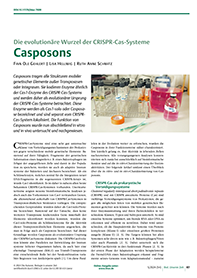Casposons: The evolutionary root of CRISPRCas systems
DOI:
https://doi.org/10.11576/biuz-7600Keywords:
Methanosarcina mazei, CRISPR-Cas, Casposon, Translokation, Transposons, Mini-Casposons, nested-PCRAbstract
Only recently, casposons have been discovered in silico in many archaea. So far, these transposable elements have only been studied by bioinformatic analyses and in vitro assays focusing on the activity of their key enzymes, the Cas1-solo enzymes. Due to these enzymes, casposons are considered to be the evolutionary origin of CRISPR-Cas systems. Recent experiments with Methanosarcina mazei confirmed their in vivo activity – excision and reintegration – using nested PCRs. The results suggest the existence of a circular casposon intermediate. Furthermore, the integration of a synthetic, plasmid-encoded mini-casposon – consisting of an R6K γ origin and two antibiotic-resistance cassettes – into the M. mazei chromosome was detected and analyzed in more detail. After successful integration, the mini-casposon was found to form a tandem structure with the native casposon MetMaz-C1.

Downloads
Published
How to Cite
Issue
Section
License
Copyright (c) 2024 Finn O. Gehlert, Lisa Hellwig, Ruth A. Schmitz

This work is licensed under a Creative Commons Attribution-ShareAlike 4.0 International License.

